Caballero B. (ed.) Encyclopaedia of Food Science, Food Technology and Nutrition. Ten-Volume Set
Подождите немного. Документ загружается.


the drying surface). If sensible heat changes are
neglected, the equilibrium between heat and mass
transfer at the drying surface may be represented by:
dw
dt
L
s
¼
dQ
dt
, ð8Þ
where L
s
is the latent heat at #
s
. Therefore, the rate of
drying may be represented by the expression:
dw
dt
¼
h
c
A
L
s
ð#
a
#
s
Þ: ð9Þ
The drying rate may be expressed in terms of the rate
of change of moisture content (dW/dt):
dW
dt
¼
h
c
A
0
L
s
ð#
a
#
s
Þ, ð10Þ
where W is the moisture content (dwb), and A
0
is the
drying surface associated with the unit mass of dry
solids. If the thickness of the slab is l, and the bulk
density of the solids is r
s
, the rate of drying may be
expressed as:
dW
dt
¼
h
c
s
L
s
l
ð#
a
#
s
Þ, ð11Þ
If W
0
is the moisture content (dwb) of the wet mater-
ial at the beginning of the constant rate period, and
W
c
is the moisture content (dwb) at the end of that
period, the duration of the constant rate period (t
c
)
may be expressed as:
t
c
¼
ðW
0
W
c
Þ
s
L
s
l
h
c
ð#
a
#
s
Þ
: ð12Þ
From the equations above, it can be seen that the
higher the temperature and the lower the humidity
of the air, the higher the rate of drying during the
constant rate period. The velocity of the air also influ-
ences the drying rate during this period by affecting
the heat transfer coefficient thus:
h
c
¼
aG
n
D
m
c
, ð13Þ
where G is the mass velocity of the air, D
c
is the
characteristic dimension of the system, and a, n,and
m are constants. D
c
has been represented by the
equivalent diameter of the flow channel (cross-
sectional area 4%perimeter) or the length of the
drying surface parallel to the direction of flow of
the air. For most tray-drying calculations, the equiva-
lent diameter is used. Values of n reported in the
literature range from 0.35 to 0.80. Where no specific
values are available, 0.80 is usually used in calcula-
tions. For situations where the air does not flow
parallel to the drying surface, alternative expressions
for h
c
are available. When some of the heat is
transferred to the drying surface by conduction or
radiation, an overall heat transfer coefficient taking
these sources of heat into account must be used.
0011Many solid foods do not exhibit a constant rate
period. Others do, but it is usually quite short. Some
recent work suggests that, if changes in dimensions of
the solid pieces during drying are taken into account,
more foods would exhibit a constant rate period.
0012As drying proceeds, a point is reached, C in
Figure 3,when the movement of moisture to the sur-
face is no longer fast enough to maintain the surface
in a saturated condition. Beyond this point, the drying
rate starts to fall and continues to do so throughout
the rest of the drying cycle. Point C is known as the
critical point and the moisture content at that point,
W
c
, the critical moisture content. The characteristics
of the material being dried and the drying conditions
influence the value of W
c
. Period C–D(Figure 1), is
known as the falling rate period. Many publications
have reported the existence of two or more falling
rate periods (see below).
0013During the falling rate period, the external condi-
tions, in particular the velocity of the air, have less
influence on the drying rate. This is determined by the
factors that affect the movement of water from
the interior of the solid to the surface. Numerous
mathematical models have been proposed to repre-
sent the falling rate period of drying. Many are based
on the mechanism whereby the moisture is assumed
to move to the surface. Several mechanisms have been
proposed, but the mechanism that has been most
widely accepted is that in which the moisture moves
by diffusion as a result of the concentration gradient
between the surface and the interior of the wet solid.
This type of movement may be represented by Fick’s
second law:
dW
dt
¼ D
d
2
W
dl
2
, ð14Þ
where W is the moisture content (dwb), t is the time,
l is the distance, and D is the liquid diffusivity.
One well-known solution to this equation, in an
abbreviated form, for a slab-shaped solid, drying
from one large face only is:
W W
e
W
c
W
e
¼
8
2
exp Dt
2l
2
ð15Þ
or
t ¼
4l
2
2
D
ln
W W
e
W
c
W
e
ln
8
2
, ð16Þ
where W is the average moisture content (dwb) at
time t, W
e
is the equilibrium moisture content
(dwb), W
c
is the moisture content at the start of the
falling rate period (dwb), and l is the depth of the slab.
1916 DRYING/Theory of Air-drying

This expression holds for values of (W W
e
)/W
c
W
e
)
less than 0.60.
0014 Eqn (16) has been widely used to calculate drying
times during the falling rate period. However, when it
is used, it is assumed that D remains constant
throughout the falling rate period. It is widely
accepted now that the value of D changes with
changes in moisture, i.e., it decreases as drying pro-
ceeds. Many authors have found that the falling rate
period could be divided into two or more stages, with
each stage having its own value of D.
001 5 D is dependent on temperature. The relationship
most widely used to describe this dependence is of the
form:
D
e
¼ D
0
exp
Q
RT
, ð17 Þ
where D
e
is the average effective diffusivity, D
0
is the
temperature-independent constant, Q is the energy of
activation for diffusion, R is the gas constant, and T is
the absolute temperature.
0016 Many empirical models, derived from experimen-
tal data, have been used to represent falling-rate
drying. One of the earliest and most widely used is:
dW
dt
¼K
c
ðW W
e
Þ, ð18 Þ
where dW/dt is the rate of drying (rate of change of
moisture content) at a moisture content W (dwb), and
K
c
is the drying constant (or mass transfer coeffi-
cient). K
c
is related to temperature thus:
K
c
¼ a exp
b
T
, ð19 Þ
where a and b are empirical constants.
0017 Integrating eqn (18) gives:
W W
e
W
c
W
e
¼ exp K
c
tðÞð20 Þ
or
t ¼
1
K
c
ln
W W
e
W
c
W
e
:ð21 Þ
Note the similarity between eqns (12) and (17). Al-
though widely used, eqn (15) often does not apply to
the whole falling-rate curve. The introduction of an
empirical exponent, n, can widen its applicability
thus:
W W
e
W
c
W
e
¼ exp K
c
t
n
ðÞ:ð22 Þ
Many other empirical models have been applied to
describe falling-rate drying. Most are only applicable
under conditions similar to those under which the
model was developed. Many are specific to a particu-
lar food or related materials.
0018Neither the diffusion model nor the empirical
model, outlined above, takes account of other changes
that may occur during drying. Shrinkage may lead to
changes in dimensions, density, and porosity of the
material undergoing drying. These changes may influ-
ence the pattern of drying. Changes in the thermal
properties of the material may influence heat transfer
and, in turn, the pattern of drying. Many more com-
plex models have been proposed that attempt to take
account of these and other changes. Treatment of such
models is outside the scope of this chapter.
0019Spray drying is widely used to dry liquids and
slurries. The feed is converted into a fine mist or
spray, which is brought into contact with heated air
in a large drying chamber. Very rapid drying takes
place, and a powder is formed, usually within 20 s.
Because of the very large surface area created, evap-
orative cooling maintains the surface of the droplets
close to the wet-bulb temperature of the air through-
out most of the drying. If it is assumed that drying
takes place under constant rate conditions, the time, t,
for a spherical droplet to dry from an initial moisture
content, W
0
, to a final moisture content, W
f
(dwb),
may be represented by the expression:
t ¼
r
2
l
L
s
W
0
W
f
ðÞ
3h
c
#
a
#
s
ðÞ1 þ W
0
ðÞ
, ð23Þ
where r is the radius of the droplet, and r
l
is the
density of the liquid.
0020In practice, not all the moisture is removed under
constant rate conditions. More detailed treatments of
drying of droplets during spray drying are available in
the literature.
See also: Drying: Chemical Changes; Equipment Used in
Drying Foods
Further Reading
Brennan JG (1994) Food Dehydration – A Dictionary and
Guide. London: Butterworth-Heinemann.
Brennan JG, Butters JR, Cowell ND and Lilly AEV (1990)
Food Engineering Operations, 3rd edn. London: Else-
vier Applied Science.
Karel M (1974) Fundamentals of drying processes. In:
Spicer A (ed.) Advances in Pre-concentration and Dehy-
dration of Foods, pp. 45–94. London: Applied Science.
Masters K (1991) Spray Drying Handbook, 5th edn. New
York: Longman Scientific and Technical.
Mujumdar AS (1995) Handbook of Industrial Drying, 2nd
edn. New York: Marcel Dekker.
Wang N and Brennan JG (1995) A mathematical model of
simultaneous heat and moisture transfer during drying
of potato. Journal of Food Engineering 24: 47–60.
DRYING/Theory of Air-drying 1917

Drying Using Natural Radiation
M. Mathlouthi, Universite
´
de Reims Champagne-
Ardenne, Reims Cedex, France
Copyright 2003, Elsevier Science Ltd. All Rights Reserved.
Background
0001 Drying of certain crops and foodstuffs is a very an-
cient and relatively easy technique for food preserva-
tion. Sun-drying has been used by early civilizations
and is still used in many tropical and subtropical
countries where solar energy remains a low-cost
heat energy. However, the traditional method, which
involves spreading the product in a thin layer on the
ground or on a platform and exposing it directly to
the sun has its drawbacks. The quality of the dried
product is reduced owing to color deterioration by
direct exposure to UV radiation, as well as damage to
unprotected products by insects, rodents, and other
animals, and microbial spoilage, especially as the
relative humidity increases. Improvements in sun-
drying have led to solar drying. This technique uses
sun as a heat source, which increases the drying
capacity of air by heating it and reducing its relative
humidity in indirect solar dryers. Recent advances
have produced cheaper solar dryers, suitable for
the drying requirements of the crop, as well as an
improved quality of the dried product. Whatever the
drying system, using either direct exposure to the sun
or circulation (natural or forced) of heated air in solar
dryers, the driving force for dehydration remains the
gradient of water vapor pressure between the product
and the surrounding air. This explains why natural
ventilation is convenient in dry areas like arid zones
of Africa or the Artic, whereas the hot and humid
air of certain tropical regions is inefficient for drying
crops. Such climatic conditions necessitate the use of
adapted solar dryers.
0002 To take advangae of solar energy, collectors are
used, generally made from low-cost packaging films
readily available in developing countries where solar
dryers have been introduced with the aim of reducing
crop losses. Solar-energy-based dryers are generally
low-temperature drying systems. Equilibrium in rela-
tive humidity between the air and the product is
generally reached at a constant ventilation rate and
an average temperature around 50
C. This kind of
drying concerns crops that are dried in bulk in their
storage devices. Fruits with a high sugar and acid
content, like raisins, figs, apricots, or dates, are
particularly well suited to natural drying outdoors.
Sometimes, a pretreatment is needed if the dehydra-
tion rate and storage stability of the product are to be
improved.
Solar Drying Systems
0003Three types of application of solar energy are used to
dry crops:
.
0004Direct – absorption of solar radiation where nat-
ural convection of the surrounding air is the origin
of mass and heat transfer;
.
0005Indirect – application of solar radiation, which is
used to preheat air in a solar collector before blow-
ing it on the crop tray and releasing it through a
chimney;
.
0006Mixed-type drying systems, which use both direct
solar heat and natural ventilation of the drying
chamber with air heated in a solar air heater.
0007There is another type of classification that con-
siders solar drying systems as passive or active,
depending on whether they rely completely on solar
radiation and natural air flow, or only partly on
solar energy, and also on other heating systems, as
well as on motorized fans. All active solar dryers use
forced convection.
Direct Solar Radiation Drying
0008Traditional open-to-sun drying This involves
spreading the crop, or the food on the ground, or
placing it on horizontal shelves exposed to sun, air,
and natural ventilation. From time to time, the crop is
stirred to reduce the drying time. This type of sun
drying is common in developing countries. Although
this method seems simple and cheap, very often, crop
losses result from fungal and insect infestation, or
unexpected rain. The quality of the dried product is
sometimes poor, such as the loss of riboflavin in cous-
cous dried under UV sun radiation as compared with
industrial hot-air-dried products. Even though large
amounts of fruits and vegetables are still sun-dried,
the development of indirect solar dryers seems the
solution for the future if it is necessary to decrease
the drying time, improve the quality, and mini-
mize crop loss.
0009Direct solar-energy absorption dryer In this type of
dryer, the solar radiation is used directly in the dryer,
which is, in this case, a cabinet dryer equipped with a
fan and sometimes an additional electric heat source
(Figure 1), or a greenhouse tunnel covered with a
glass or a polyethylene plastic cover about 150 mm
in thickness and, in some cases, with UV and far-
infrared protection. In the greenhouse-type dryer
(Figure 2), the solar-heated air is circulated through
the product by a fan. A metallic structure made of
arches connected by longitudinal tubes and supported
on vertical lateral tubes is used. This structure is
covered with a polyethylene film of the same type as
1918 DRYING/Drying Using Natural Radiation
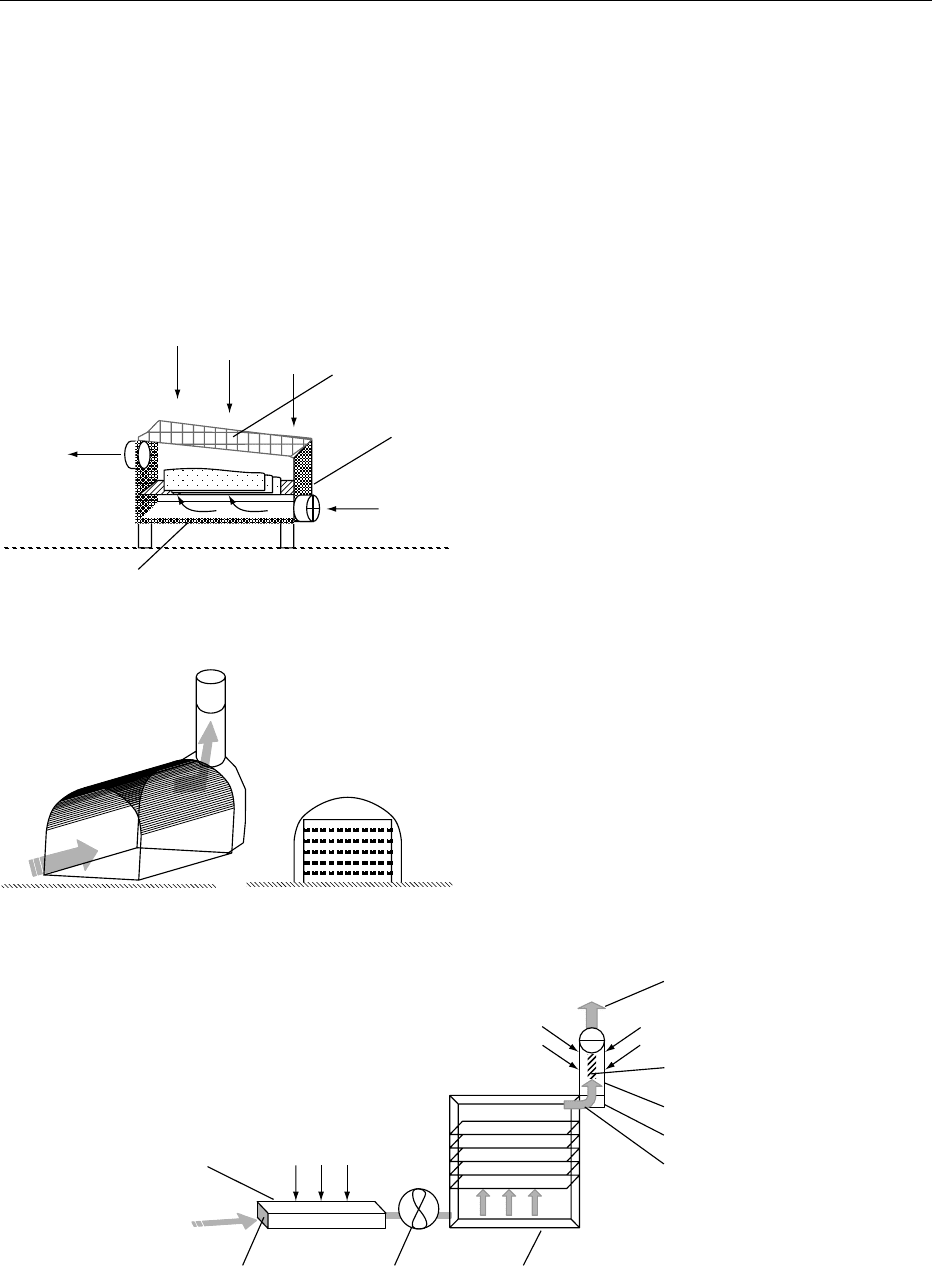
that used in cultivation greenhouses. Recycling of air
in a transparent plastic tube is possible. Fans at the air
inlet and exit allow an increased ventilation rate.
0010 Storage-type dryers have roofs that act as a solar
collector. In other cases, both the roof and the wall act
as collectors. The wall is usually black painted con-
crete covered with glass and is both a collector and a
means of heat storage.
0011 Indirect solar dryer In this type of dryer (also called
a distributed-type air-circulation solar dryer), the crop
is placed on shelves in an opaque drying chamber. The
drying air is heated in a separate solar collector and
distributed by either natural or forced (fan) circula-
tion. In this dryer, the crop is not exposed to sun, thus
preventing vitamin loss and other UV-sensitive
reactions like lipid oxidation. The air temperature
is higher than in direct sun-dryers, which reduces
the drying time. A typical solar dryer is shown in
Figure 3. Clearly, the equipment and maintenance
costs of this type of drier are more than that of the
direct sun dryer. Efficiency is increased if forced-air
convection is installed. The optimization of indirect
solar dryers also depends on the quality of the solar
energy heating the collectors.
0012Mixed solar dryer This type of dryer incorporates
both direct and indirect solar-energy drying. The
dryer consists of a preheated air chamber, a drying
chamber and a chimney. However, the drying cham-
ber in this case is glazed so that the product also
receives direct solar energy as well as a flow of drying
air (Figure 4). Depending on the countries and
product, the heat absorber may be made of low-cost
recovered byproducts, as in rice drying, where a layer
of burnt rice husk covered with a transparent plastic
sheet on an inclined bamboo network is used as the
air heater’s absorber. Direct absorption of solar heat
in the drying chamber takes place through a transpar-
ent plastic film, which also protects the crop against
rain and other degradation agents. In the multi-
stacked dryer, different products can be dried at the
same time on a series of shelves. Also, the drying
chamber has a column exposed on one side to the
sun through glazing and, on the opposite side, a
wooden access door and vents, thus obviating the
need for a chimney.
Solar radiation
Glazing
Drying product
Air inlet
Air outlet
Insulated wall
fig0001 Figure 1 Cabinet solar dryer.
air
fig0002 Figure 2 Greenhouse-type solar dryer.
Humid air
Insulated wallFanFiltration screen
for inlet air
Chimney
Transparent side
Absorbing surface
Air outlet
Solar
radiation
Solar
radiation
Transparent film
Air
fig0003 Figure 3 Indirect solar dryer consisting of a collector, drying chamber, and chimney.
DRYING/Drying Using Natural Radiation 1919
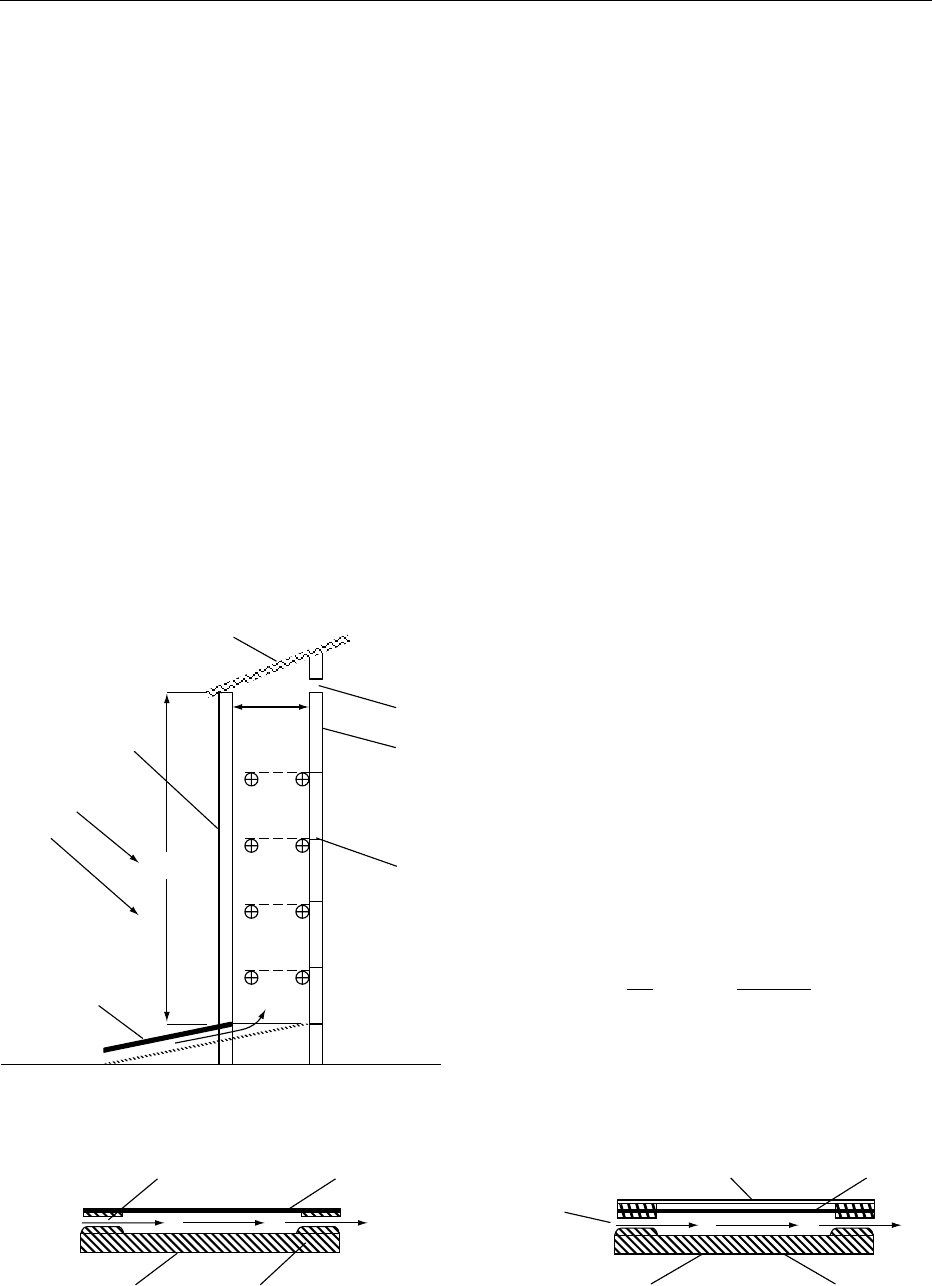
Solar Heat Collectors
0013 Solar collectors take advantage of the thermal energy
of solar radiation. There are two types: the bare flat-
type collector and the covered-plate heat absorber.
The surface of the plate is usually painted black; this
absorbs sun radiation and transmits it in the form of
heat to the drying air. The air flow through the col-
lector is by natural convection or by means of a fan.
The efficiency of a collector can be determined by
measuring the inlet and outlet temperatures, the
surface of the collector and flow rate of the air, and
the solar energy available.
Bare Flat-plate Collectors
0014 These collectors consist of a simple air duct with the
upper side acting as a heat absorber and the lower
surface acting as an insulator (see Figure 5). Import-
ant losses of thermal energy are observed at the upper
surface, which limits the use of such collectors to low-
temperature drying like crop drying in storage silos.
In this type of collector a flat plate of aluminum can
be used as a heat absorber. The heat loss is reduced by
placing the air duct in a box filled with glass wool
insulation.
Covered-plate Heat Collector
0015To minimize heat losses from the upper side of the
collector, glass, plexiglass, or transparent plastic is
used as a cover material, placed parallel to the
metallic absorber plate. Covered-plate solar-energy
air heaters are much more efficient than bare-plate
collectors. The air to be heated can be sucked between
the absorber and the transparent cover, or sometimes
underneath the absorber to prevent dust contamin-
ation at the surface of the absorber. In this case, the
air circulates between the lower face of the absorber
plate and the insulation layer, the upper surface of
which is in contact with a static layer of air under-
neath the glazing. This type of back-pass air heater
(Figure 6) is more efficient than one where air flows
between the absorber and the cover.
Efficiency of Solar-heat Collectors
0016Efficiency is defined as the ratio of thermal energy
used to heat the drying air over the total solar
energy absorbed by the collector in the same time
period. The heat used to warm air in the collector is
expressed by:
Q
a
¼ m
a
C
pa
T
0
TðÞ,
where Q
a
is the heat transmitted to air in the collector
(J s
1
), m
a
is the mass flow rate of air through the
collector (kg s
1
), C
pa
is the specific heat capacity of
air (J kg
1
K
1
), T
0
is the collector outlet temperature,
and T is the inlet temperature (generally ambient).
0017If A is the collector area (m
2
) and I the flux of
incident solar radiation (W m
2
), the total incident
energy of the exposed surface of collector is Q
i
¼ AI,
and the efficiency ratio (Z) can be expressed as:
¼
Q
a
Q
i
¼ m
a
C
pa
T
0
TðÞ
AI
:
0018In forced-convection air dryers, m
a
is easy to meas-
ure, as well as the inlet and outlet temperatures. For
natural convection, the flow rate of air is difficult to
Shelf
Hot air
1.50 m
0.5 m
Access
door
Solar
radiation
Glass wall
Transparent roof
Black
galvanized
iron sheet
Vent
fig0004 Figure 4 Mixed solar-energy dryer.
Airflow Absorber
InsulationBox
fig0005 Figure 5 Flat-plate collector.
InsulationBox
Air inlet
Glazing Absorber
fig0006Figure 6 Back-pass air heater.
1920 DRYING/Drying Using Natural Radiation

determine precisely, hence the efficiency ratio is meas-
ured. Incident solar radiation absorbed by collector
depends on the properties of the material used for
the design of the collector like absorbance, transmit-
tance, and reflectance. It is also a function of the
position of the sun relative to the collector, the
solar altitude angle, and the sunrise and sunset of
the collector orientation. A value of 1 kW per square
meter of exposed surface may be considered as an
optimum.
Application of Solar Drying to Selected
Crops
0019 Solar drying is an effective mode of dehydration
especially for certain crops (cereal grains, grapes,
figs, sweet pepper, thyme) in countries with good
sunshine during the harvest period. Many developing
countries have sufficient insolation for sun or solar
drying, but the dryer needs to be of the right design to
minimize crop losses resulting from contamination by
insects, molds, and poor storage conditions. In de-
veloping countries, greenhouses can be used as solar
dryers during the warm period of the year, thus redu-
cing the cost of investment of setting up a new dryer.
Solar collectors may be made from low-cost poly-
ethylene film traditionally used to cover greenhouses.
In all cases, covered heat collectors and drying cham-
bers are preferable to open-air sun dryers to prevent
crop spoilage.
Solar Drying of Grapes
0020 Traditional drying of grapes is still used in many
countries and involves spreading or hanging the
product on galvanized wires (with a coverage of
about 15–20 kg m
2
) on the racks. A typical dryer
contains six to 10 racks each about 50 m long, 2 m
tall, and 1.5 m wide. Racks are placed on open high
land to allow free air flow. The period of drying varies
from 8 to 20 days, depending on the grape variety,
treatment, and climate conditions. The water content
in the grapes is reduced from about 3 kg of water per
kilogram of dry matter in fresh product to about
0.16 kg of water per kilogram of dry matter in the
dried product. Solar dryers using either direct or
indirect solar energy have higher drying rates than
sun dryers. These rates are improved when grapes
are pretreated. Pretreatment solutions contain 4–5%
K
2
CO
3
and 1–2% dipping oil. Changing the surface
tension of grape by dipping for a few minutes in
dipping solution increases water diffusion through
the waxy cuticle and decreases the drying time.
0021 The quality parameters of solar-dried grapes, espe-
cially color, moisture content, and acidity, are more
uniform than those of the sun-dried product. Storage
stability is improved with SO
2
gas pretreatment and
conditioning in a modified atmosphere (1% O
2
; 20%
CO
2
) packages.
Solar Drying of Other Crops
0022For obvious economic reasons, if a solar dryer is
preferred to an open-air sun dryer, it should work to
full output. Therefore, it has to be a multipurpose
dryer equipped for both low-temperature (below
50
C) and high-temperature (above 50
C) drying,
eventually using the calories produced by the com-
bustion of agricultural waste as part of the total ther-
mal energy required. Tunnel greenhouse dryers are
very efficient during sunny days and can be used
with an auxillary combustion heating system to
ensure a continuous operation. This type of solar
dryer is used for sweet pepper and garlic in Argentina.
In terms of mold contamination, the quality of the
product is better on sunny days than on cloudy,
humid days. A complementary heating source is
needed to improve drying during humid periods and
to increase the working time. Products like thyme can
be dried at about 50
C using a wire basket solar
dryer. Sun-dried thyme herb is suitable for packaging
or grinding as a powder. In terms of the essential oils
extracted after drying, sun-dried thyme is of a better
quality than that of oven-dried thyme, but the
percentage of oleoresin is the same for both drying
methods.
Quality of Solar-dried Products
0023Sun drying usually takes too long, and even solar
drying lasts several days. Such a long process favors
degradation reactions, especially when the water
activity is relatively high, above 0.60. Moreover,
the storage conditions should be controlled so that
the temperature is maintained below 10
C for grain
and nut storage, and the relative humidity below
40%. This requires cooling and dehydration of air.
However, if precautions (e.g., the use of clean crops)
are taken to minimize spoilage, high-quality sun-
dried products can be produced. Other precautions
include the use of covered plate absorbers and the use
of clean drying air. The first stages of dehydration
(first and second day) should be carried out on
sunny and dry days. The most dangerous contamin-
ation is fungal damage, which can yield mycotoxins.
Among the mycotoxins, such as ochratoxin, citrinin,
and ergosterol found in grains and nuts, aflatoxins
are the most important as regards toxicity, occur-
rence, and economic consequences, especially in
developing countries.
0024Other degradation reactions such as browning,
lipid oxidation or vitamin loss may be minimized by
using adequate protection in the dryer. For example,
DRYING/Drying Using Natural Radiation 1921

it is preferable to use low temperatures as well as the
UV radiation filtration using colored glazing.
Conclusion
0025 Solar drying has proved to be technically and eco-
nomically valuable for several crops. It is, however,
necessary to develop large-scale dryers that may be
used throughout the year for different products to
make them attractive to the farmers.
0026 Protection against UV radiation, dust, insects,
mold, and other sources of contamination, as well
as temperature and relative humidity control, are
needed to improve the quality of the product. Like-
wise, the storage conditions of solar-dried products
should be tailored to the crop and the packaging
optimized if a long shelf-life is required.
See also: Drying: Theory of Air-drying; Physical and
Structural Changes; Equipment Used in Drying Foods
Further Reading
Condori M, Echazu R and Saravia L (2001) Solar drying of
sweet pepper and garlic using the tunnel greenhouse
driers. Renewable Energy 22: 447–460.
Ekechukwu OV and Norton B (1999) Review of solar-
energy drying systems II: an overview of solar drying
technology. Energy Conversion & Management 40:
615–655.
Exell RHB (1980) A basic design theory for simple solar
dryes. Renewable Energy Review Journal 1: 1–14.
Pangavhane DR and Sawhney RL (2002) Review of
research and development work on solar dryers for
grape drying. Energy Conversion & Management 43:
45–61.
Fluidized-bed Drying
J G Brennan, The University of Reading, Reading, UK
Copyright 2003, Elsevier Science Ltd. All Rights Reserved.
Principles of Fluidization
0001 If air is made to flow through a bed of solid particles
supported by a perforated plate or grid, frictional
drag will cause a pressure drop to develop across the
bed. The drag, and hence the pressure drop, will
increase as the air velocity increases. When the fric-
tional force overcomes the weight of the particles they
move apart, and the bed expands and begins to behave
like a fluid. In this state it is known as a ‘fluidized bed.’
The air velocity at which fluidization first occurs is
known as the ‘incipient (or minimum) fluidization
velocity.’ This velocity can be calculated, for spherical
particles, using the relationship:
n
f
¼
ðr
s
rÞg
m
d
2
e
3
180ð1 eÞ
where n
f
(m s
1
) is the minimum fluidization velocity,
r
s
(kg m
3
) is the density of the solid particles,
r (kg m
3
) is the density of the air, g (m s
2
) is accel-
eration due to gravity, m (N s m
2
) is the viscosity of
the air, d (m) is the diameter of the particles, and e is
the voidage of the bed (the fraction of the bed that is
void). As the air velocity increases above the min-
imum value, bubbles of air pass up through the bed.
These bubbles are small when they leave the perfor-
ated plate. As they pass up through the bed they
coalesce to form larger bubbles. The movement of
these bubbles causes mixing of the solid particles in
the bed. As the air velocity increases, mixing becomes
more vigorous. At some stage particles will leave the
surface of the bed and fall back on to it. At a still
higher velocity the particles become entrained in the
air and are carried away in the exhaust air stream.
The velocity at which this first occurs is known as the
‘entrainment velocity.’ This velocity may be calcu-
lated, for spherical particles, by means of the rela-
tionship:
n
c
¼
ffiffiffiffiffiffiffiffiffiffiffiffiffiffiffiffiffiffiffiffiffiffiffiffiffiffiffiffiffi
4dðr
s
rÞ
3C
d
r
s
where n
c
(m s
1
) is the entrainment velocity and C
d
is the drag coefficient. C
d
has a value of 0.44 when
the Reynolds number of the air is in the range
500–200 000. When heated air is used to fluidize a
bed of particles containing moisture, dehydration of
the particles will occur. This is the principle of the
fluidized-bed drier.
Fluidized-bed Driers
0002Food particles suitable for fluidized-bed drying
should be in the size range 20 mm to 10 mm, uniform
in size and shape, and not very sticky. They should
not break up easily when subjected to impacts and
abrasion in the bed. Some food materials, e.g., cereal
grains, fluidize readily over a wide range of moisture
contents. Other foods will only fluidize at low mois-
ture content. In the latter cases the wet product may
be fluidized by dispersing it in a bed of already dried
material.
0003Fluidized-bed drying chambers equipped with a
mechanical agitator to help disperse wet or sticky
materials are available. The agitator is located near
1922 DRYING/Fluidized-bed Drying
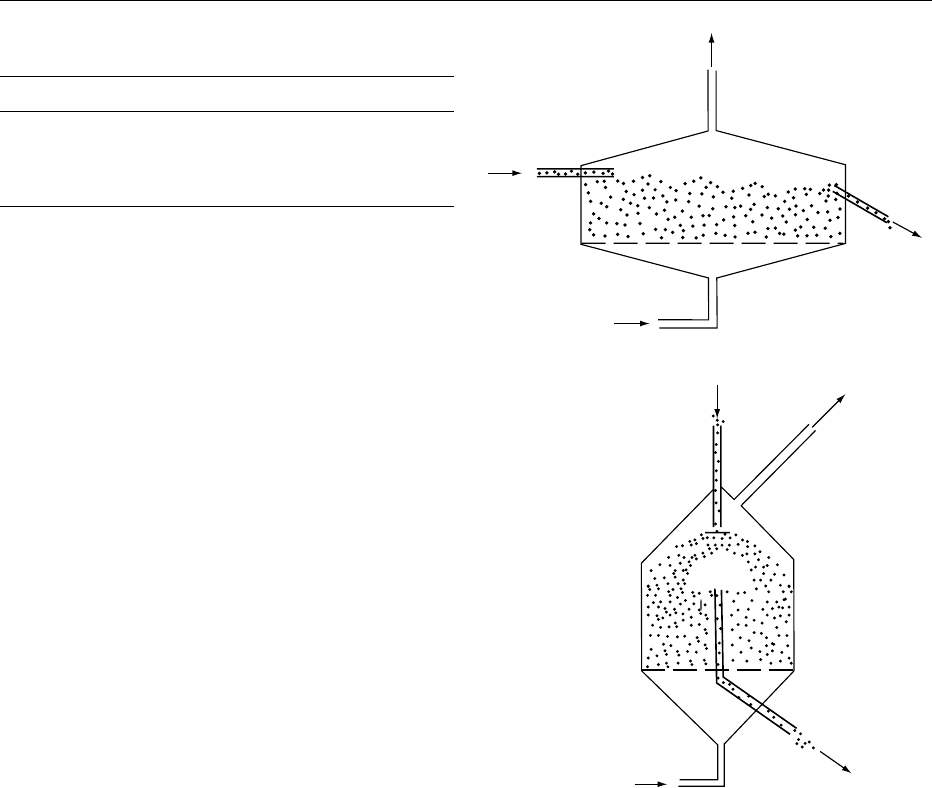
the feed inlet. It disintegrates the feed and disperses
the pieces into already dry material, thus facilitating
fluidization. Some semisolid foods may be converted
into a form suitable for fluidized-bed drying by
mixing them with some dried material, and extruding
and cutting the mixture into suitably sized pieces.
0004 The air velocity should be as high as possible to
promote rapid drying. The upper limit is often deter-
mined by the loss of fine product, created in the bed,
with the exhaust air. Some loss of fines may be toler-
ated in order to achieve high drying rates. The fine
particles may be recovered from the outgoing air by
means of cyclones or fabric filters. Typical air veloci-
ties for fludizing particles with densities in the range
1000–2000 kg m
3
are presented in Table 1.
0005 For most food applications the support for the bed
is a simple perforated plate. For very fine particles
more complex designs incorporating jets or bubble
caps, similar to those in distillation plates, may be
used. Fluidized-bed driers usually operate at atmos-
pheric pressure. However, by suitable location of fans
they may be run at pressures above or below atmos-
pheric pressure. Heater plates may be incorporated
into the drying chamber to improve heat transfer.
These are not common in food applications. The
drying conditions can be accurately controlled in
batch-operated fluidized beds. High rates of drying
and uniform moisture content in the product can be
achieved. However, batch units are only used for
small-scale operations.
0006 There are two types of continuous fluidized-bed
drier which differ in the pattern of flow of the par-
ticles and air. The plug-flow type (Figure 1a) has a
relatively long narrow bed. The feed is introduced at
the wet end and moves to the dry end in a plug-flow
pattern where the dry product is discharged over an
adjustable weir. The distribution of the residence time
of the particles is relatively narrow so that uniform
drying is accomplished. However, its application is
limited to feed particles which are readily fluidizable.
In the well-mixed, or backed-mixed, fluidized bed
(Figure 1b) the ratio of the length of the bed to its
width is unity or below. The particles are vigorously
mixed and the bed will have a relatively uniform
temperature. The wet feed is introduced into a bed
of relatively dry particles and is quickly dispersed.
Thus, it can handle feeds that are difficult to fluidize.
On the other hand, there is a broader distribution of
particle residence time, as compared with the plug-
flow design, and the product moisture content may be
less uniform. The well-mixed bed is best at removing
surface moisture, whereas the plug-flow type removes
moisture from within the particles. The latter type is
most widely used for food applications. Figure 2
shows a continuous plug-flow fluidized-bed drier
equipped with a cyclone for the recovery of fines.
Vibrated Fluidized-bed Driers
0007Fluidized-bed driers may be fitted with vibrating
bases, to help move the product horizontally from
tbl0001 Table 1 Typical gas velocities for fludidizing different-sized
particles
Averageparticlesize(mm) Velocity (m s
1
)
100 – 300 0.2 – 0.4
300 – 800 0.4 – 0.8
800 – 2000 0.8 – 1.2
2000 – 5000 1.2 – 3.0
From Hovmand CV (1995) Fluidized bed drying. In: Mujumdar AS (ed.)
Handbook of Industrial Drying, 2nd edn, pp. 195–248. New York: Marcel
Dekker with permission.
(a)
(b)
fig0001Figure 1 Representations of (a) a continuous plug-flow fluid-
ized-bed drier and (b) a continuous well-mixed fluidized-bed
drier. Adapted from Mujumdar AS (ed.) (1995) Handbook of Indus-
trial Drying, 2nd edn, by courtesy of Marcel Dekker: New York.
DRYING/Fluidized-bed Drying 1923
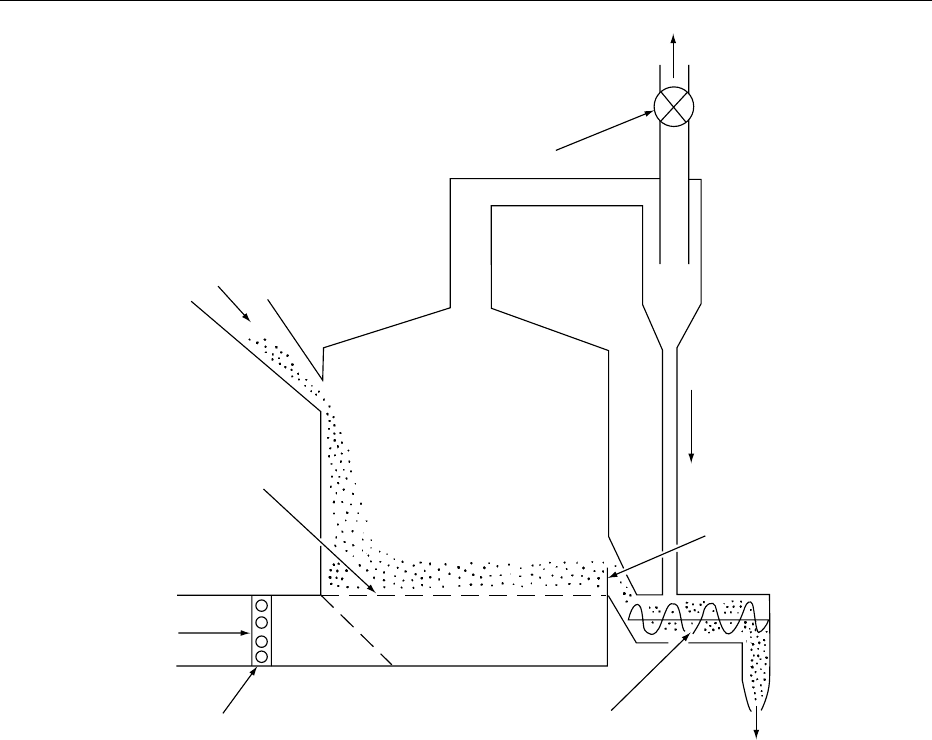
the wet end to the dry end. This motion is gentle
and suitable for handling fragile materials and
agglomerates susceptible to mechanical damage. A
vibrating bed is capable of handling particles less
uniform in size as compared with the stationary-
type bed. A vibrating bed is also better at handling
sticky materials. The air velocity required to keep the
particles moving is usually much less in a vibrated bed
than in a stationary one. Bases vibrate in the fre-
quency range 5–25 Hz and a half amplitude of a few
millimeters. Such beds are also known as ‘vibro-
fluidizers.’
Multistage Fluidized-bed Drying
0008 A number of fluidized-bed driers may be used in
series. This enables better control of the drying con-
ditions at different stages in the cycle and can yield a
product with a more uniform moisture content as
compared with a single-stage drier. The use of a
multistage system may also lead to energy savings.
One possible combination is a well-mixed bed, to
remove surface moisture, followed by a plug-flow
bed to complete the drying. Alternatively, a number
of plug-flow beds may be used in series. The latter
arrangement is mainly used for the food applications.
Up to six stages may be used. Vibrating beds are
usually employed. The particles fall under gravity
from one stage to the next. Such an arrangement is
also known as a ‘cascade system.’
Applications
0009Single-stage and multistage fluidized-bed drying
systems are used for a wide range of food materials.
These include peas, sliced beans, diced carrots,
onions, potato granules, meat cubes, grains, flour,
salt, and sugar. The air temperature is selected to
suit each product. Vibrating fluidized beds are used
as after driers and coolers following spray drying. The
Air heater
Air in
Porous plate
or gird
Feed in
Exhaust air out
Fan
Fines
Weir
Product out
Screw conveyor
fig0002 Figure 2 A continuous plug-flow fluidized-bed drier equipped with a cyclone for the recovery of fines. From Brennan JG, Butters JR,
Cowell ND and Lilly AEV (1990) Food Engineering Operations, 3rd edn. London: Elsevier Applied Science with permission.
1924 DRYING/Fluidized-bed Drying
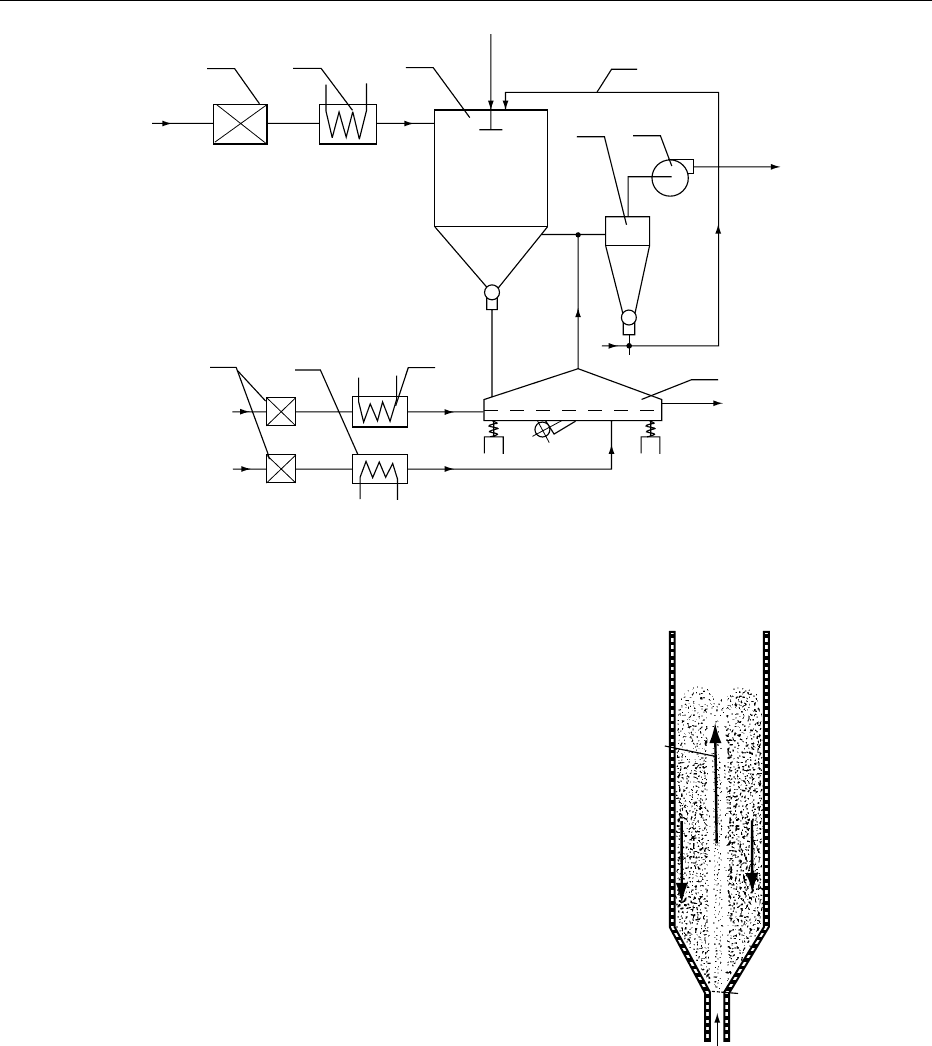
powder from the spray drier has a moisture content of
5–7%. This is reduced to 3–4% on a vibrofluidizer
using dry air at a relatively low temperature. Such
two-stage drying is said to facilitate better control
over the quality of the product and lead to savings
in energy as compared with straight-through spray
drying. Some agglomeration of the powder particles
may occur in the fluidized bed which can improve the
reconstitution characteristics of the product. Such a
system is shown in Figure 3. The product may be
cooled in the same vibrofluidizer or in a second unit
in series with it. Cooling the product facilitates hand-
ling and packaging. Spray driers are available with
fluidized beds built into the main drying chamber.
These are known as integrated fluidized-bed spray
driers.
Spouted-bed Drier
0010 One particular design of fluidized-bed drier is the
spouted bed. In this type of drier the drying air enters
at high velocity through a nozzle located centrally in
the conical base of the chamber (Figure 4). This
creates a spout of fast-moving particles up through
the center of the bed. These particles return to the
base of the chamber as a slow-moving annular bed
surrounding the spout. A proportion of the inlet air
flares out into this annular bed and flows upwards,
countercurrent to the downward-moving particles, at
a relatively low velocity. In the spout, high rates of
heat and mass transfer occur, resulting in high initial
rates of drying. As a result of evaporative cooling
the temperature of the particles in the spout is kept
relatively low. The later stages of drying take place in
the annular bed under relatively mild conditions. This
type of drier is suitable for drying relatively large
particles, greater than 5 mm in diameter. It can cope
with heat-sensitive materials. During start-up a high
12
2
4
7
65
8
31
fig0003 Figure 3 A two-stage spray-drying process for milk: 1, air filter; 2, heater; 3, cooler; 4, spray drier; 5, cyclone; 6, exhaust fan;
7, fluidized-bed drier; 8, return line for powder. From Mujumdar AS (ed.) (1995) Handbook of Industrial Drying, 2nd edn, by courtesy
of Marcel Dekker: New York.
Air in
Screen
Spout
fig0004Figure 4 The principle of the spouted-bed drier. From Brennan
JG (1994) Food Dehydration ^ A Dictionary and Guide. Oxford:
Butterworth-Heinemann with permission.
DRYING/Fluidized-bed Drying 1925
